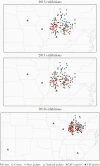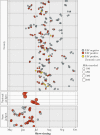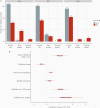Tracing the Source of Influenza A Virus Zoonoses in Interconnected Circuits of Swine Exhibitions
- PMID: 33686399
- PMCID: PMC7989509
- DOI: 10.1093/infdis/jiab122
Tracing the Source of Influenza A Virus Zoonoses in Interconnected Circuits of Swine Exhibitions
Abstract
Background: Since 2011, influenza A viruses circulating in US swine exhibited at county fairs are associated with >460 zoonotic infections, presenting an ongoing pandemic risk. Swine "jackpot shows" that occur before county fairs each summer intermix large numbers of exhibition swine from diverse geographic locations. We investigated the role of jackpot shows in influenza zoonoses.
Methods: We collected snout wipe or nasal swab samples from 17 009 pigs attending 350 national, state, and local swine exhibitions across 8 states during 2016-2018.
Results: Influenza was detected in 13.9% of swine sampled at jackpot shows, and 76.3% of jackpot shows had at least 1 pig test positive. Jackpot shows had 4.3-fold higher odds of detecting at least 1 influenza-positive pig compared to county fairs. When influenza was detected at a county fair, almost half of pigs tested positive, clarifying why zoonotic infections occur primarily at county fairs.
Conclusions: The earlier timing of jackpot shows and long-distance travel for repeated showing of individual pigs provide a pathway for the introduction of influenza into county fairs. Mitigation strategies aimed at curtailing influenza at jackpot shows are likely to have downstream effects on disease transmission at county fairs and zoonoses.
Keywords: United States; animals; farms; human-animal interface; influenza A virus; pandemic risk; prevalence; public health; swine; transmission; zoonoses.
© The Author(s) 2021. Published by Oxford University Press for the Infectious Diseases Society of America. All rights reserved. For permissions, e-mail: journals.permissions@oup.com.
Figures






References
-
- Reid AH, Taubenberger JK. The origin of the 1918 pandemic influenza virus: a continuing enigma. J Gen Virol 2003; 84:2285–92. - PubMed
-
- Webster RG. The importance of animal influenza for human disease. Vaccine 2002; 20(Suppl 2):S16–20. - PubMed
-
- Smith GJ, Vijaykrishna D, Bahl J, et al. Origins and evolutionary genomics of the 2009 swine-origin H1N1 influenza A epidemic. Nature 2009; 459:1122–5. - PubMed
Publication types
MeSH terms
Grants and funding
LinkOut - more resources
Full Text Sources
Other Literature Sources

